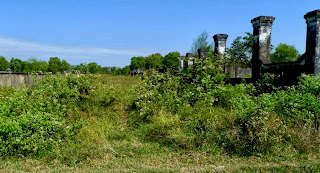5. Mansions and Monkeys
It must have been a fabulous time when French business men, engineers, contractors, the French military, and the bureaucrats established the city of Sihanoukville as the main, and only seaport in Cambodia. Up to 1955 overseas trade in Cambodia, and equally in Vietnam and Laos, was conducted solely through the Mekhong river, since all three countries were under French rule (French Indochina). This situation changed dramatically after Vietnam gained independence from France in 1954, making it a necessity to built a new deep sea harbor. The town selected was Sihanoukville.
 |
| New French-designed Sihanoukville port under construction (1958) |
 |
| The French roaring sixties in Sihanoukville, Champagne inclusive, imported from home. |
 |
| Sihanoukville 1960. |
On my rides through the outskirts of town I notice the formerly elegant walls and iron gates surrounding empty sites. I like to call Sihanoukville the city of an unfinished, or destroyed (?) French real estate dream.
The formerly upper-middle class neighborhoods of the French can be found mostly along the beautiful bays and beaches, Independence Beach, and Victory Beach. None of the mansions which were surrounded by these walls still stand. It is also possible that they were never built in the first place, and the city is a vast landscape of unfulfilled real estate speculation. It all ended with the barbaric rule of the Khmer Rouge, and subsequently with the bombing raids of the U.S. military at the end of the Vietnam war. I don't know the answer, maybe the history of real estate under French colonial rule here still needs to be written. It would be a fascinating topic; I am positive about that.
The most splendid hotel at the time, also built by the French, the modernistic Independence Hotel, actually still exists, or a reincarnation in a renovated state. The Khmer Rouge used it for target practice for their rocket launchers and machine guns, but it is back and occupies the same magnificent beach like in the French roaring sixties.
The majestic walls are designed and executed in exactly the same French style which I remember from my childhood. Today they don't have to guard much more than grazing cattle, sleepy, non-aggressive dogs, and lots of landscape. The French designers at the time loved to experiment with precast concrete forms, and many such elements can still be seen here in the remoteness of Sihanoukville's formerly affluent suburbs. The typical French iron gates are still in place too, at least where they were not stolen for scarp metal.
Of course Sihanoukville with it's pristine beaches has enormous potential as a future travel destination. I hesitate to imagine how it will look in, say, 30 years from now.
And I won't be around to re-visit, at least not on a motorcycle.
Occupying the empty sites of French real-estate aspirations and dreams are families of nicely behaved monkeys. They sit on the fences, or jump from tree to tree. Of course there is a street vendor nearby who sells hands of bananas, some 20 fingers in one hand, for one dollar. Of course I had to stop and buy one from the vendor lady; the monkeys seem to be not overly hungry but some couldn't resist the offer.
 |
| I like the light-blue eyeshadow. |






















"I don't know the answer, maybe the history of real estate under French colonial rule here still needs to be written." what a great idea, and a super finale to a sabbatical! and a reason to go back for more research.
ReplyDelete